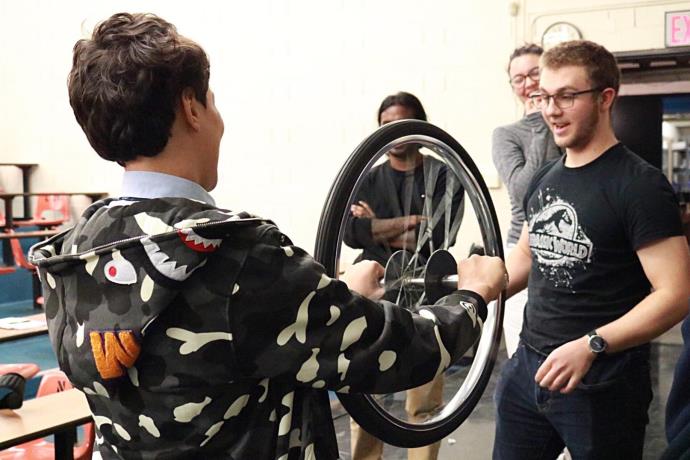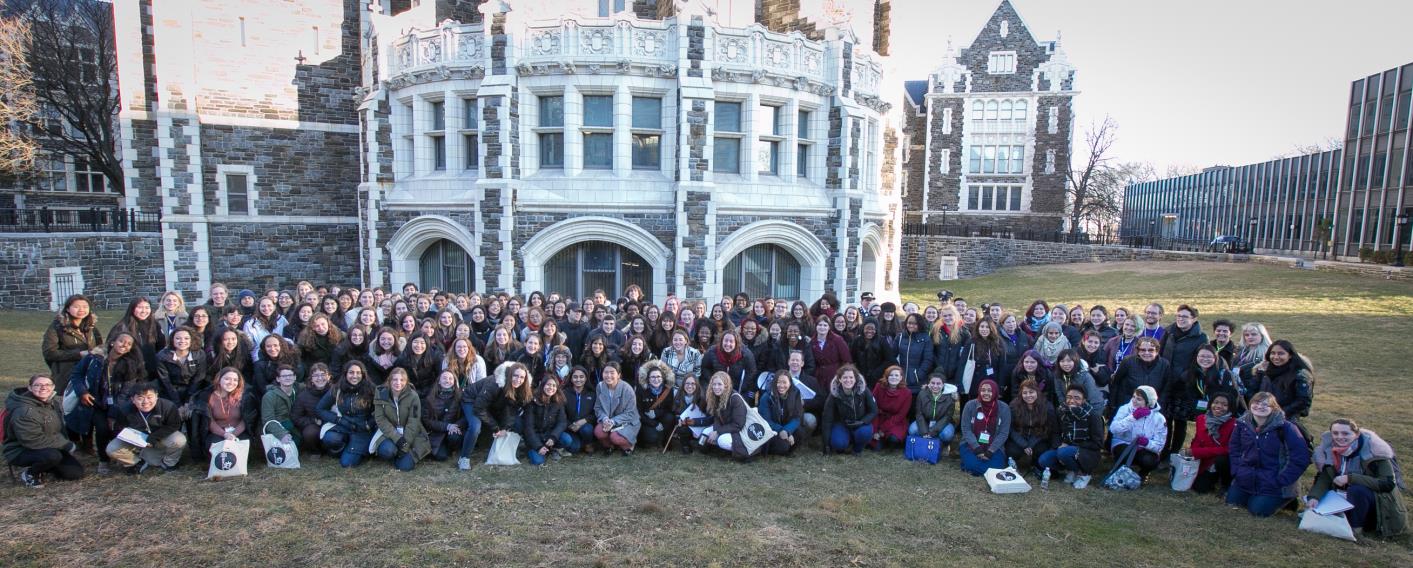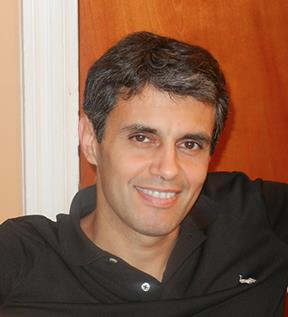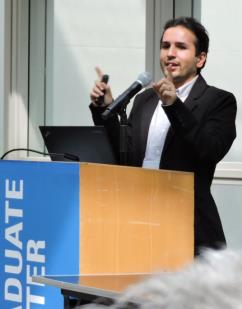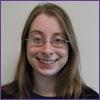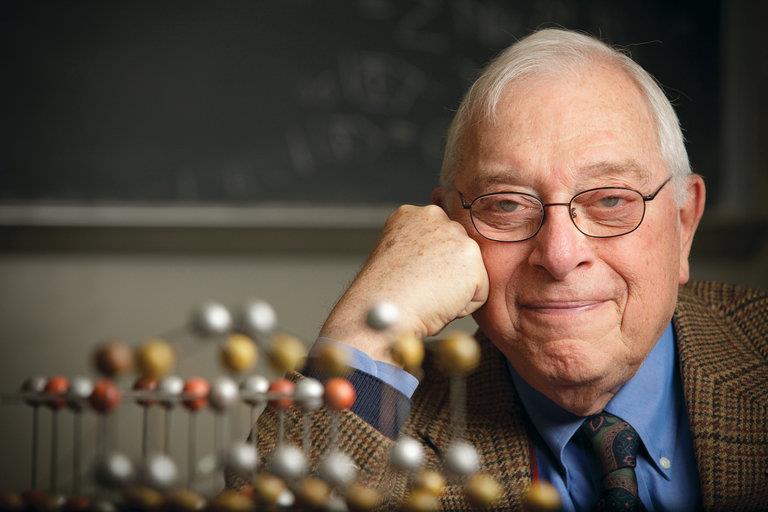Department of Physics Newsletter Volume 10
Physics Club receives national recognition
The Physics Club of CCNY received the “Notable SPS Chapter” recognition from the National Council of the Society of Physics Students (SPS) for their accomplishments during the 2016 - 2017 academic year. The selection is based on engagement with national SPS programs, the professional physics community, the campus community, as well as outreach to K-12 grade students, public outreach, community service, and contributions to student recruitment and retention.
The CCNY Club is a new SPS chapter but they are working from a strong tradition of community outreach and campus involvement that was lauded by the SPS National Council in their review of the chapter’s activities. In addition to general meetings, the Physics Club organized a number of campus-based events throughout the year. First of such events is hosting the “Physics Major’s Month” (October 2016, 2017) to attract prospective physics students and build the department community. The activities included lab tours, a lecture on the 2016 Nobel Prize in Physics by Professor Pouyan Ghaemi, a Student Research Symposium, and a guest lecture by Drs. Shannon Greco and Francesca Poli from the Princeton Plasma Physics Lab on plasma physics and opportunities for undergraduate women in physics. In May 2017, they hosted a panel discussion by graduating Physics students who had been accepted to top Ph.D. programs to share their experiences with younger students on how to navigate graduate school applications and standardized tests. Later in 2017, Professor Alexios Polychronakos presented a seminar on Gravity Wave detection and 2017 Nobel Prize in Physics.
The outreach activities of the Club included organizing enriching activities for inner city students with local middle schools and high schools, as well as with the Bridge Golf Foundation (BGF). The work with local schools involved students visiting CCNY labs, where the Club members presented interactive demonstrations (see the adjoining photo for a demonstration on angular momentum) to further their understanding of physics concepts. BGF is a local organization whose goal is to improve life outcomes for young men of color by blending golf with STEM learning, mentoring, and character education. The Physics Club worked with the BGF to organize the first annual Harlem Water Fair. Club members worked with high school students at BGF to develop physics experiments related to water conservation and present those at the fair.
The key players in organizing last year’s activities were Veeshan Narinesingh (a second year Ph.D. student), James Malaguit (a Master’s student) and Ethan Bendau, a senior undergraduate physics major. Professor Sebastian Franco is the Physics Club advisor. Dr. James Hedberg generously provided time and guidance to build and operate the demonstrations used in the outreach events.
(Contributed by Ethan Bendau)
Fourth Cummins Lecture
The fourth Hermann Z. Cummins Lecture was presented on February 22, 2017 by Dr. Charles Marcus, Villum Kann Rasmussen Professor and Director of the Center for Quantum Devices at the Niels Bohr Institute, University of Copenhagen, Denmark. His talk, “Semiconductor-superconductor hybrids for topological quantum computing” reviewed the theoretical motivation and the recent experimental progress in Majorana zero modes in semiconductor-superconductor hybrid materials.
The engineering challenges of building a topological quantum computer has many interesting intermediate milestones that stimulate and challenge condensed matter physics.
Hermann Z. Cummins (1933-2010) was a Distinguished Professor of Physics at the City College of New York. The lecture is sponsored by the Cummins Memorial Fund and the City College Fund.
Legacy in Science and Human Rights: Memorial Symposium for Joseph L. Birman
Colleagues, students, family and friends gathered on Monday, October 9, 2017 to celebrate the life and work of Joseph L. Birman (1927 - 2016), Distinguished Professor of Physics at the City College of New York (CCNY). Professor Birman passed away on October 1, 2016 (please see a companion piece on his scientific contributions and career highlights).
The program was divided into several sessions. Dr. Tony Liss, the Dean of Science, opened the morning session paying homage to Dr. Birman’s many contributions to Physics, human rights, as well as to the City College and City University as a dedicated faculty member and mentor of students and researchers. Chaired jointly by Distinguished Professor Robert Alfano and Professor Jiufeng Tu, the morning session featured several technical presentations by Professor Birman’s former students, postdoctoral associates and colleagues. The first talk of the session, “Topological Phase Transitions and a Two-Dimensional Weyl Superconductor in a Superconductor/ Half-Metal Heterostructure” was presented by Professor Chin-Sen Ting of the University of Houston. He was followed by Professor Barry Klein of UC Davis, whose talk was titled, “My Research on High-Temperature Superconductivity: From A15’s With Joe Birman to Superhydrides.” Dr. Alexander Efros of Naval Research Laboratory discussed his personal and scientific contacts with Dr. Birman in his presentation, “Quantum Dots and Talking with Joe Birman.” Some brief remarks on Dr. Birman’s scientific contributions followed. Dr. Joan Birman, Joe’s wife of 66 years (they married in 1950) and a Columbia professor emeritus of mathematics, closed the session by thanking the organizers of the symposium.
Symposium attendees had lunch at the CCNY Faculty Dining Room. Mr. Kenneth Birman, Dr. Birman’s youngest son, briefly reminisced memories of his father. Lunch was followed by a visit to the recently established Birman-Cummins Reading Room in the CCNY Department of Physics.
Professor Joel Gersten chaired the first of the two afternoon sessions, “Remembering Joe.” Speakers included Professors Robert Alfano, Miguel Fiolhais, Joel Gersten, Joe Malinsky, Que Hong Nguyen, and David Schmeltzer. The speakers had fond recollections of their interactions with Professor Birman. The second afternoon session, “Joe’s Human Rights Work” was chaired by Dr. Eugene Chudnovsky, Distinguished Professor of Physics at Lehman College of CUNY. The speakers were Professors Joel Lebowitz of Rutgers University (on behalf of the American Physical Society (APS) Committee on the International Freedom of Scientists), Alexander Greer of Brooklyn College (on behalf of the Committee of Concerned Scientists); Betty Tsang of Michigan State University and Eugene Chudnovsky. Professor Birman was widely known and admired for his humanitarian work with ‘refusenik’ scientists of former Soviet Union, dissident Chinese scientists, and their East European counterparts. For his work on the human rights of scientists worldwide, he received the Heinz R. Pagels Human Rights Award of the New York Academy of Sciences, and shared the Andrei Shakharov Award of the APS with two fellow activists. Some of the attendees gathered for dinner at a Manhattan restaurant and remembrance continued later into the evening.
Conference for Undergraduate Women in Physics (CUWiP) held
On Jan 12-14, The City College of New York CCNY), Columbia University, and Barnard College jointly hosted the 2018 Conference for Undergraduate Women in Physics (CUWiP) in the New York City (NYC) region, one of the 12 regional CUWiPs held in different regions of the country. The first CUWiP was held in 2006 at the University of Southern California. Adopted by the American Physical Society, CUWiPs has become popular and this year the combined number of attendees (approximately 2000) attending all twelve regional conferences has been comparable to the number of women receiving an undergraduate degree in Physics (approximately 1600).
Approximately 200 students attended the NYC regional CUWiP, and for many of them, this was the first opportunity to experience a professional conference, get information about graduate school and professions in physics, and access to other women in physics of all ages with whom they can share experiences, advice, and ideas. It was an action-packed three days for attendees, who visited Columbia on Friday evening, Barnard on Saturday morning, CCNY on Saturday afternoon and evening, and back to Columbia on Sunday until 1 PM. There were excellent talks on topics in Astrophysics, Condensed Matter Physics, Undergrad Research, Nano-Fabrication, Work/Life Balance, How to Give a Compelling Physics Talk, and much more. There were breakout sessions, networking, student talks, lab visits, awards, and social events.
The events that took place at CCNY were exciting and exceptionally well received. It was a crisp, clear, sunny day that showed our campus and the surrounding views at their very best. There was a keynote address by Pat Burchart (Stanford) that was streamed to all 12 CUWiP sites; an energetic hike down to the new science buildings CDI and ASRC) on South Campus (the conferees were very impressed with the quality of our research and facilities); an excellent, in-depth panel discussion on Careers in Physics.
Then there was the dinner at the Faculty Dining Room, where CCNY Dean of Science Tony Liss welcomed the conferees and cheered them on. During dessert, Professor Myriam Sarachik commented on the remarkable change in the landscape for undergraduate women since her entry into the field many years ago, enjoining them to continue to push and work hard toward further increasing the percentage of female physicists. There were various fun activities after dinner: James Hedberg presented two Planetarium shows (which they loved), a showing of “Hidden Figures” – an excellent film that was perfect for this conference. Some students left campus to ice skate in Central Park.
Faculty Accomplishments and Awards
Meriles wins the first FRED Award
Carlos Meriles is the first winner of the Frontiers in Research Excellence and Discovery (FRED) Award, initiated by the Research Corporation in 2016. The FRED Award supports the exceptional high risk/high reward research at the early stages. The research is expected to have the potential to transform a field of scientific research. Meriles will use the $250 K award to fund the study of the spin and electrical behavior of negatively-charged nitrogen-vacancy (NV) centers with high spatial resolution. The results of the study may have useful applications in quantum computing.
Professor Meriles was also recently (2015) elected Fellow of the American Physical Society (APS), “For creative contributions to the development of novel techniques in magnetic resonance, including ex-situ MRI scanning, spin hyperpolarization and optical detection.” He was nominated by the Division of Materials Physics.
Quantum dances of electrons to the tune of light
In a recent publication entitled, “Light-Induced Fractional Quantum Hall Phases in Graphene” [Phys. Rev. Lett. 119, 247403 (2017)], CCNY physicists Areg Ghazaryan and Pouyan Ghaemi together with their collaborators Tobias Graß, Michael J. Gullans, and Mohammadi Hafezi from the Joint Quantum Institute at the University of Maryland proposed using laser light to create novel fractional quantum Hall (FQH) states. The FQH effect refers to a collective behavior of a two-dimensional electron system in which the Hall conductance exhibits quantized plateaus at fractional values of (e2/h). These authors conducted a theoretical study of a monolayer of graphene under orthogonal magnetic field at low temperature. Under these conditions electrons may be considered to move in closed orbits, each with an expected size and energy. Each orbit may be populated by a definite number of electrons. In partially filled orbits interaction between charged particles leads to their arrangement into a form where all of the electrons are entangled with each other and may be viewed as involved in a collective quantum dance. Realization of such phases requires careful control and manipulation of system parameters. This work explores the use of resonant light for realization of different phases. The light can nudge electrons into jumping between orbits of different energies. As a result, the interactions between the electrons change and lead to different phases or “dance patterns.” The intensity and frequency of the light alter the number of electrons in specific orbits enabling flexible control the phases. Such phases are envisioned to have novel applications in developing quantum computers, the authors suggest.
Ghaemi wins Feliks Gross Award
Pouyan Ghaemi, Assistant Professor of Physics received the 2017 Feliks Gross award from CUNY Academy of Arts and Sciences. Feliks Gross award, which is the highest award for assistant professors at CUNY, was given in recognition of Pouyan's work in the field topological phases of quantum materials. The results have been published in well-recognized journals. He has developed fruitful collaborations with several faculty members of the department.
Predicting election trends with twitter data
CCNY Physics Department and Benjamin Levich Institute researchers Alexandre Bovet, Flaviano Morone, and Hernán A. Makse are using a combination of Percolation theory, statistical physics of complex networks, natural language processing, and machine learning in an analysis of a network of election-related interactions between Twitter users created from retweets, replies, quotes, and hashtags to explore the feasibility of predicting election results. They used their analytics to study the 2016 US Presidential election. They were able to anticipate the New York Times polling average by up to 13 days, providing a more instantaneous snapshot of general public opinion than classic polling techniques were able to. Their work was featured in an article in Science [John Bohannon, “The Pulse of the People,” Science 355 (6324), 470-472 (2017)]. “Although there is still work to be done before a completely accurate method of prediction is attained, the tools we are developing at present are a step firmly in the right direction,” asserts a posting in Professor Makse’s website.
Lubell continues science advocacy
Michael Lubell, Mark W. Zemansky Professor of Physics at CCNY, is keeping constant vigil on the consequences that the science and technology policies of the current administration may have on economy, energy, climate change, scientific research, and other arenas. Professor Lubell has a long track record in science advocacy, having served as the director of public affairs and head of the Washington, D.C., office of the American Physical Society (APS) for 22 years. Since March 2017, he has been representing CCNY in Washington and has continued his science advocacy work through the media. Over the past year, he has written and co-authored several widely read opinion pieces in leading publications, such as, The New York Times, Scientific American, The Hill, and The San Francisco Chronicle. His co-author in several of these opinion columns is Burton Richter, winner of Nobel Prize in Physics (1976) and recipient of the Presidential Medal of Science (2014). The titles of some of these columns will provide an indication of the range of issues being discussed: “By Investing in Science, Trump can strengthen the Economy,” (with Burton Richter, The New York Times, February 16, 2017); “Cutting Science Research Won’t Help President Trump Achieve His Goals,” (The Hill, March 23, 2017); “President Trump’s Futile Plan to Restore Coal Jobs,” (with Burton Richter, The San Francisco Chronicle, April 3, 2017); “Science Under the Populist Gun,” (Scientific American, April 20, 2017); “Washington needs high-level science and technology expertise – now!” (with Burton Richter, The Hill, May 26, 2017); and “Trump, remove your blinders on climate change,” (with Burton Richter, The Hill, September 11, 2017). Professor Lubell has delivered invited talks and seminars on these issues in different forums. He also keeps CCNY and CUNY community informed about federal science funding and its impact.
Ellianna Schwab, Class of 2017 Valedictorian
Ellianna Schwab, Physics major, was the Class of 2017 valedictorian at the 171st Commencement Exercises of the City College of New York on June 2. Ellianna graduated from the Macaulay Honors College with research honors in Physics and a 3.9 GPA. She received an NSF Graduate Research Fellowship, and is pursuing her graduate studies in Astrophysics at UC Berkeley. While at CCNY, Ellianna won several prestigious awards, such as, Barry Goldwater Scholarship (2016), the Chambliss Astronomy Student Achievement Award for Best Undergraduate Poster (2016); Best Poster, Columbia University Astrofest 2016 and Astrocom NYC Scholar (2015). Her undergraduate research involved determining the age of brown dwarf stars (see Newsletter, Volume 9 for a complete account).
Undergraduate Students Receive Awards
The Physics Department gives out several awards and scholarships to undergraduate students every year. The awards for 2016-2017 Academic Year were presented on May 4, 2017. Shreya Upadhyaya received the Sidney Millman Scholarship that is presented to the junior Physics major demonstrating high potential. The Sonkin Medal was awarded to Raymond L. Dudley for demonstrating the best performance in the Physics laboratory course(s) and/or in experimental research. Raymond L. Dudley, Cody J. Duell, Lukas W. Lindwasser and Aaron Joseph Somoroff received the Ward Medal that is presented to the graduating physics major with the highest GPA in physics and mathematics courses. Raymond L. Dudley, Cody J. Duell, Aaron Joseph Somoroff and Henry Hingyin Wong are the recipients of the Bernard Hamermesh Scholarship, which recognizes the outstanding graduating Physics major, who has demonstrated some of the skills, knowledge, technique and imagination necessary for a successful Experimental Physicist and who shows promise of being an active contributor to the research efforts in some branch of Experimental Physics. Luis A. Sanchez received the Gerry A. Gelbwachs Scholarship that is awarded to the Physics major demonstrating academic excellence and high potential to benefit society. Martin A. Tiersten Scholarship recognizes the students with the highest performance in Mechanics (Physics 35100), and the recipient of the scholarship this year is Daniela Quigee. Harry Soodak Scholarship given to the outstanding junior physics major who wants to pursue a career in Physics went to Kevin Becker. The students graduating with Research Honors in Physics are Cody J. Duell, Oscar J. Flores, Lukas W. Lindwasser, Azmain H. Nisak and Ellianna Schwab. Merna Youssef received the Kenneth Singer Memorial Award which pays $1000 yearly to a highly motivated and promising physics sophomore for up to three years.
The Zemansky Introductory Physics Prize recognizes outstanding scholarship in Introductory Physics 20700 or Physics 20800 courses. Thirty five students received the award in the 2014-15 academic year. Students demonstrating outstanding scholarship in both Introductory Physics 20700 and Physics 20800 receive the Zemansky Introductory Physics Prize, Honorary and the recipients are: Moshfaq Ahmed, Liam Boylan, Tahsin Jahin, Mohammad Kameli, Dylan J. Kirdahy, Shihao Pan, Pooneet Thaper and Adam Zalesko.
Recent PhD’s
Zhiyi Chen defended his Ph. D. thesis, “Tuning Topological Surface States by Charge Transfer” on August 5, 2016. Professor Lia Krusin-Elbaum is his mentor.
Tal Galfsky conducted research for his Ph. D. thesis, “Control of Spontaneous Emission from Quantum Emitters Using Hyperbolic Metamaterial Substrates” under the tutelage of Professor Vinod Menon. He defended his thesis on August 24, 2016.
Arthur J. Parzygnat defended his Ph. D. thesis entitled, “Some 2-Categorical Aspects in Physics” on July 22, 2016. Distinguished Professor V. Parameswaran Nair was his mentor.
Professor Sergey Vitkalov supervised the Ph. D. thesis of William A. Meyer entitled, “The Effects of Tilted Magnetic Field on Quantum Transport in 2D Electron Systems.” He defended his thesis on January 27 to receive the degree in February 2017.
Giovanni Milione defended his thesis, “Vector Beams for Fundamental Physics and Applications” on March 10, 2016. Distinguished Professor Robert Alfano was his thesis advisor.
Lei Fang completed his degree requirements in September 2017. His Ph. D. thesis, “Detecting Majorana Fermion Induced Crossed Andreev Reflection,” was supervised by Professor David Schmeltzer.
Zheng Sun defended his thesis, “Control of Light-matter Interaction in 2D Semiconductors,” for the September 2017 degree. Professor Vinod Menon is his mentor.
Witold A. Szejgis carried out his research under the supervision of Professor Marilyn Gunner. He defended his thesis, “Continuum Electrostatics Analysis of the Kok Cycle of Photosystem II,” to satisfy requirements for the September 2017 degree.
The department congratulates the new Ph. D.s and wishes them success in their future endeavors.
New Graduate Students
Graduate students in the Ph.D. program, who came to the department in 2016 fall, are: Sahana Das Bhattacharyya, Haiming Deng, Umesh Khaniya, Mandeep Khatoniar, Francesco Lavini, Ian Leifer, Mengyao Li, Veeshan Narineshing, and Yingying Zhang. The department extends warm welcome to these new graduate students.
New Research Associates
Lin Zhang-Chen is a new research associate at the Institute for Ultrafast Spectroscopy and Lasers (IUSL), directed by Distinguished Professor Robert Alfano. Dr. Lin Zhang-Chen received her Ph.D. in Biomedical Engineering from the City College of New York. At ISUL she is working on developing optical methods to improve disease diagnosis, such as, triple negative breast cancer, skin cancer, and brain cancer.
Biswanath Chakraborty and Sriram Guddala are new postdoctoral research associates at the Laboratory for Nano and Micro Photonics (LaNMP) directed by Professor Vinod Menon. Dr. Chakraborty is currently working on strong coupling of photons and excitons in two-dimensional (2D) materials. He received his PhD in Physics from Indian Institute of Science, Bangaluru, India working on electronic transport in graphene and other 2D materials.
Dr. Guddala graduated from School of Physics, University of Hyderabad, India in 2013. Prior to coming to CCNY he was a post-doctoral researcher at the Indian Institute of Technology, Kanpur. Dr. Guddala is a recipient of the US-India Science and Engineering Research Board post-doctoral fellowship. He is currently working on using metamaterials for controlling light-matter interaction in 2D materials.
Siddharth Dhomkar, Harishankar Jayakumar, Rama K. Kamineni, and Pablo R. Zangara are postdoctoral research associates at the Laboratory for Optospintronics and Quantum Sensing (LOQUS) directed by Professor Carlos Meriles. Dr. Dhomkar received his Ph.D. in Physics from the City University of New York, investigating magneto-optical properties of semiconductor quantum structures. At LOQUS, he explores charge and spin dynamics associated with defect centers in diamond.
Dr. Harishankar Jayakumar received his Ph.D. in Physics from the University of Innsbruck, Austria working on quantum optics experiments to generate single and entangled photons from semiconductor quantum dots. His first postdoctoral research at the University of Calgary involved the development of diamond nanoopto-mechanical devices. At LOQUS he is working on diamond color center based spin quantum systems for nanoscale sensing applications. His recent research interest also includes quantum emitters in 2D materials.
Dr. Rama Kamineni received his Ph.D. in Physics from Indian Institute of Science, Bangalore working on quantum information processing using Nuclear Magnetic Resonance. At LOQUS, he is working on hyperpolarizing nuclear spins through optical pumping of Nitrogen-Vacancy (NV) centers in diamond.
Dr. Pablo Zangara received his Ph.D. in Physics from Universidad Nacional de Cordoba, Argentina, working on spin dynamics and decoherence. At LOQUS he is working on spin and charge dynamics at the nanoscale using NV centers in diamond.
Flaviano Morone is a postdoctoral researcher with Professor Hernan Makse at the Levich Institute. He received his Ph. D. in Physics from Sapienza University of Rome, Italy. His areas of research interests include complex networks, systems biology, and statistical physics.
Shiqi Li is a postdoctoral research associate at the low-temperature Physics lab of Distinguished Professor Myriam Sarachik. She received her Ph. D in Physics from CUNY working under the supervision of Professor Sarachik. Her research interests are in single molecular magnets, strongly-correlated 2D electron system, and low temperature physics.
Johannes Kirscher is a postdoctoral associate in the nuclear theory group of Professor Brian Tiburzi developing effective Standard Model descriptions for small nuclei. Prior to this, he was working at the Racah Institute of Physics of the Hebrew University in Jerusalem, and briefly at Ohio University, Athens. Dr. Kirscher’s Ph. D. research on a pion-less description of light nuclei was carried under the supervision of Professor Griesshammer at the George Washington University in Washington DC.
In Memory
Glimpses of Joe Birman’s Scientific Contributions
The Physics Department at City College felt a great loss when Distinguished Professor Joseph L. Birman passed away on October 1, 2016. Professor Birman was active in research in condensed matter theory since his arrival at our department in 1973. He served as a faculty member in the physics department of New York University before joining CCNY. Prior to that, he was a research scientist at General Telephone and Electric Laboratories.
Professor Birman had a unique way of applying his expertise in mathematics to all the cutting edge problems in condensed matter physics. He had a genuine passion for and thorough mastery of group theory, the elegant and powerful branch of mathematics tailor-made for the study of the role of symmetry in physics. His most recent projects involved Lie groups and Lie algebras, relating to continuous symmetries. These included the study of the contraction of the Lie Group SO(4) to ISO(3), the contraction of Lie algebra representations using the direct limit, and the strong contraction of the representations of three-dimensional Lie algebras. He worked out the properties of the decomposition of the direct product at arbitrary points in the Brillouin zone. He applied symmetry to the study of decagonal quasicrystals, crystals which lack translational symmetry but are nevertheless ordered. His studies extended to higher dimensional spaces, because they shed light on processes in the real world. He developed a character table for the hypercubic point group in six dimensions, a problem related to the study of quasicrystals in three dimensions. He employed the dynamical group SU(8) to study the thermodynamics of phase coexistence. He analyzed the electronic structure of quasiperiodic systems and quasilattices. He served on a subcommittee on the nomenclature for crystallographic symbols.
Professor Birman was also a world-renowned leader in the field of superconductivity. Recent collaboration with C. N. Fiolhais examined size effects in the Ginzburg-Landau theory. Other projects analyzed phenomenological correlations in high temperature superconductors. Yet another recent study involved following the implications of gauge invariance and spontaneous symmetry breaking in two-gap superconductors. He mentored his most recent doctoral student, Yasmin Gurcan, in developing a theory of the BCS-BEC (Bardeen-Cooper-Schrieffer – Bose-Einstein Condensate) crossover. He formulated a theory about the competition between the order parameters resulting in the possible coexistence of superconductivity and ferroelectricity and studied their electrodynamic properties.
Professor Birman was interested in a wide variety of physical systems. These included the Raman scattering of vortex light, where the photons carry well-defined azimuthal quantum numbers, and the symmetry predicted transitions in 3-dimensional topological insulators and their selection rules. The optical properties of the material Cu2O had long fascinated him. His most recent study involved the effects of their polaritons on optical bistability and optical hysteresis. He extended this study to heterostructures involving organic molecules coupled to Cu2O. He was interested in the nonlinear optical properties of quantum dots, such as how their optical properties are modified by an organic medium. He generalized this study to include arrays of quantum dots.
Prof. Birman provided strong theoretical support for the experimentalists in the department, including Profs. Alfano and Tu, as well as other condensed matter theorists. He was always hosting eminent international scientists both for long- and short-term visits. He was a powerful role model for all that knew him. He will be sorely missed in our department.
(Contributed by Joel Gersten)
Important Events
Birth: May 21, 1927 to Max and Miriam Birman, in the Bronx
Education: Bronx High School of Science (1943); B. S. (cum laude) in Chemistry, City College of New York (1947); Ph. D. in Theoretical Chemistry, Columbia University (1952).
Marriage: Married Joan Sylvia Lyttle in 1950; three children Kenneth, Deborah and Carl David.
Employment: Senior Scientist, GTE Labs (1952-1962); Professor of Physics, New York University (1962 – 1974); Henry Semat Professor of Physics, CCNY (1974 – 1988); Distinguished Professor of Physics, CCNY (1988 – 2016).
Mentoring: Mentored 35 Ph.D. students, 40 postdoctoral associates
Selected Awards and Honors: Fellow, American Physical Society (1960), Japanese Society for Promotion of Science (1978), John S. Guggenheim Memorial Society (1980-81), Lady Davis Fellowship Trust (1981); Received Docteur es Sciences, honoris causa from Universite de Rennes (1974); Heinz Pagels Award of the New York Academy of Sciences for the support of Human Rights of Scientists (2003); and APS Andrei Sakharov Prize (2010), “For tireless and effective personal leadership in defense of human rights of scientists throughout the world.”
Death: October 1, 2016 in New Rochelle, New York.
The Physics Department is reaching out to its alumni and friends to help support CCNY’s Physics programs by contributing to the City College Fund. Please mark your contribution, “For Physics Department Use” andsend to: City College Fund, Shepard Hall #166, CCNY, 160 Convent Avenue, New York, NY 10031.
Last Updated: 07/04/2020 10:52

